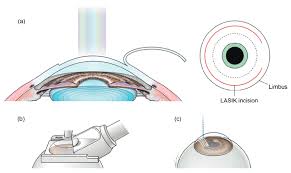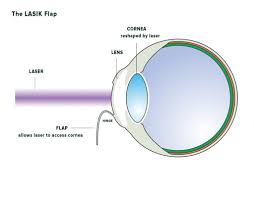Table of Contents
ToggleSMILE (Small Incision Lenticule Extraction) Pro surgery is popular for addressing vision disorders like myopia and astigmatism. It is a minimally invasive operation that reshapes the cornea and improves eyesight. However, some people may require a second SMILE Pro operation after the first. This raises worries regarding the safety and efficacy of the product. So, Can the Smile Pro Procedure Be Repeated? Let’s check!

What Exactly is SMILE Pro Surgery?
SMILE Pro Surgery is a very new and complex type of eye surgery, including reshaping the cornea with a femtosecond laser. Small Incision Lenticule Extraction (SMILE) refers to the small incision made in the cornea to retrieve the lenticular or the tissue that causes nearsightedness or myopia. The femtosecond laser used in SMILE Pro Surgery is incredibly accurate and may make lenticules as small as a few millimeters in diameter. This minimally invasive technique takes less than 30 minutes to complete, making it a popular alternative to standard LASIK surgery.
SMILE Pro Surgery is intended to correct myopia or nearsightedness, a prevalent refractive problem affecting millions worldwide. Astigmatism, which causes impaired vision owing to an uneven shape of the cornea or lens, can also be corrected with the operation. The FDA has certified SMILE Pro Surgery as a safe and effective technique. It has a high success rate and a minimal risk of problems, making it a popular alternative for those who want to enhance their eyesight but want to avoid wearing glasses or contact lenses. SMILE Pro Surgery is generally safe and successful, but you should speak with a trained eye surgeon to see if it is correct.
The Benefits and Drawbacks of SMILE Pro Surgery
There are advantages and disadvantages to consider before getting SMILE Pro Surgery.
One of the primary benefits of SMILE Pro Surgery is that it is minimally invasive, resulting in less discomfort and a shorter recovery period than other vision correction treatments. In addition, SMILE Pro Surgery has a decreased risk of problems, such as dry eyes and corneal flap issues, which are frequent with conventional laser eye operations.
One of the most significant disadvantages of SMILE Pro Surgery is that it is unsuitable for patients with high prescriptions or astigmatism. The method is likewise novel, and long-term evidence of its usefulness and safety must be gathered. After the procedure, some patients may have transitory adverse effects such as dry eyes, glare, and halos.
Considering SMILE Pro Surgery, assessing the advantages and downsides, and sharing any concerns with your eye surgeon is critical. Based on your requirements and circumstances, they can help you decide if the surgery is right for you.
Is it possible to get SMILE Pro Surgery twice?
One often-asked issue is if it is safe to repeat the surgery. The quick answer is that it is dependent on several things.
First, it is critical to understand that SMILE Pro Surgery is a permanent surgery that reshapes the eye’s cornea. The operation aims to correct refractive defects like nearsightedness, farsightedness, and astigmatism. As a result, in most circumstances, repeating the operation may not be necessary.
However, a second procedure may be necessary if the initial technique fails to produce the intended outcomes. A second treatment may be required if the patient’s vision changes. Talking with your ophthalmologist in such circumstances is critical to evaluate if a repeat treatment is safe and essential.
It is also important to note that the safety of a repeat SMILE Pro Surgery depends on several circumstances, including the patient’s overall health, the state of the eye, and the time interval between the two surgeries. Your ophthalmologist will assess these variables and advise you on the best action.
Factors to consider -Can the Smile Pro Procedure Be Repeated?
Getting SMILE Pro surgery for the second time is feasible, but there are crucial elements to consider.
To begin, it is critical to consider why you wish to repeat the operation. Is it because the earlier operation failed to produce the anticipated outcomes, or has the eyesight degraded with time? It is essential to get the advice of an experienced ophthalmologist who can do a comprehensive examination to decide whether the treatment is appropriate or necessary.
Another thing to think about is the healing process. To improve eyesight, the SMILE Pro operation includes generating a flap in the cornea and reshaping it. The healing process might take many weeks; repeating the treatment before the eyes have completely healed increases the risk of problems. It is critical to wait until the eyes have recovered before resuming the treatment.
The patient’s age and overall health should also be considered. Most people are safe after SMILE Pro surgery, although there may be greater risks for elderly patients or those with specific health issues. Before repeating the surgery, addressing any health issues with the ophthalmologist is critical.
Complications and risks connected with numerous SMILE Pro surgeries
SMILE Pro Surgery is a common and successful technique for eyesight correction. However, there are risks and consequences, as with any surgical operation. The risks and consequences rise when having SMILE Pro Surgery more than once.
Corneal haze is one potential side effect of several SMILE Pro Surgeries. Corneal haze is a cornea clouding caused by improper healing of the corneal tissue following surgery. This can cause hazy vision and may necessitate different therapy.
Another potential consequence is corneal thinning. Each SMILE Pro Surgery removes a tiny amount of corneal tissue, and several procedures can weaken the cornea, leaving it more prone to injury or damage.
Furthermore, any surgical operation has the danger of infection, and several procedures increase this likelihood. If you’re experiencing unexpected symptoms or problems, keeping in touch with your surgeon and adhering to post-operative care instructions is important.
Assessing the dangers and consequences is crucial before opting for any of the multiple viable SMILE Pro Surgeries. You and your surgeon must explore the alternatives and determine what is optimal for your circumstances. Ultimately, the imperative consideration is prioritizing safety.
Conclusion
It may only be crucial or recommended for certain individuals to undergo the procedure again. All in all, SMILE Pro surgery is both a reliable and safe option for rectifying vision problems. Your eye specialist should be consulted to assess whether a redo surgery would benefit your situation. To determine if further procedures are required, they will examine your ocular health and assess the outcome of your original operation.
A second procedure can greatly improve certain patients’ visual acuity and overall well-being, but it is essential to consider the potential pros and cons. Although SMILE Pro surgery presents a low risk of complications, no surgery is without risks. Therefore, it is important to consider the possible advantages and disadvantages of revision surgeries. Your eye specialist should be involved in deciding if it is appropriate for you to undergo SMILE Pro surgery for the second or subsequent time. Your unique situation should guide your decision after considering the benefits and potential risks carefully.













